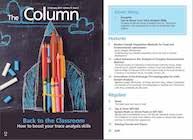Elevated Uranium Concentrations Found in Groundwater of Rio de Janeiro Region
Researchers from the PUC-Rio in Rio de Janeiro, Brazil, have found unexpectedly high uranium concentrations in groundwater samples from the mountainous region near Rio de Janeiro City.
Photo Credit: dabldy/stock.adobe.com

Researchers from the Pontifícia Universidade Católica do Rio de Janeiro (PUC-Rio) in Rio de Janeiro, Brazil, have found unexpectedly high uranium concentrations in groundwater samples from the mountainous region near Rio de Janeiro City (1). The samples contained up to 930 µg/L of uranium, approximately 30 times higher than the World Health Organization (WHO) guidance level. The figures were a cause for concern because the area contains a large amount of tourism and water-related industries, such as mineral water and breweries.
Despite its radioactive nature, the main concern from elevated uranium elements derives from its chemical toxicity, rather than its long-term radiological toxicity (2). The main threat from elevated levels of uranium being impaired kidney function (2).
Samples originating from the Rio De Janeiro state mountainous region were analyzed at PUC-Rio’s Water Characterization Laboratory (LABAGUAS), including physical-chemical assays and the determination of major cations and anions by ion chromatography, and trace elements by inductively coupled plasma–mass spectrometry (ICP-MS).
Researchers found elevated uranium concentrations in groundwater in seven of the 16 counties belonging to the Rio De Janeiro state. The wells with elevated uranium concentrations also presented high radon content, and 210Pb concentrations above the WHO guidance level of 0.1 Bq/L These findings are particularly worrying as the drilling of deep artesian wells is a growing trend in the region; researchers recommend that any new wells deeper than 80 m have mandatory testing for uranium and 222Rn as well as further studies on existing wells.
References
- J.M. Godoy et al., J. Braz. Chem. Soc.30(2), 224–233 (2019).
- B. Smith, British Geological Survey www.bgs.ac.uk/downloads/start.cfm?id=416

Measuring Vitamin K1 Concentrations in Dogs with Chronic Enteropathy Using LC–MS/MS
May 14th 2025A joint study between the University of Tennessee (Knoxville, Tennessee) and the University of Pennsylvania School of Veterinary Medicine (Philadelphia, Pennsylvania) compared directly measured vitamin K1 (vitK1) concentrations in healthy dogs and dogs with chronic enteropathy (CE) using liquid chromatography tandem mass spectrometry (LC–MS/MS); they also investigated whether supplementation of vitK1 in dogs with CE would significantly increase vitK1 concentrations.
HPLC 2025 Preview: Fundamentally Speaking (Part 2)
May 14th 2025Michael Lämmerhofer from the Institute of Pharmaceutical Sciences, University of Tübingen, Germany, spoke to JFK Huber Lecture Award winner of 2024 Torgny Fornstedt, professor in analytical chemistry and leader of the Fundamental Separation Science Group, Karlstad University, Sweden, about his pioneering work in high performance liquid chromatography (HPLC) with a focus on fundamentals, ion-pair chromatography, and oligonucleotide applications.

.png&w=3840&q=75)

.png&w=3840&q=75)



.png&w=3840&q=75)



.png&w=3840&q=75)











